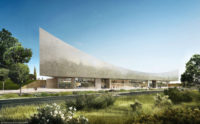
A contract is set to be signed in October with New York City-based architect Rafi Segal and collaborators, who were selected in a global competition to design the new $70-million National Library of Israel, located in Jerusalem.
Segal, born and educated in Israel and also licensed there, was chosen on Sept. 12 for the replacement structure, along with two Israeli architects and participants from the Harvard University Graduate School of Design. Segal is a former instructor there.
While the competition attracted more than 80 unsolicited and invited proposals with international participation, it was not without controversy.
Construction of the 40,800-square-meter structure, set to begin in 2014 and be completed in 2017, will be financed mostly through private funds.
Segal's collaborators HyperBina Inc., the design firm of Bing Wang, a Harvard lecturer. Also on the project team are others with Harvard connections, including architects Will Choi, Yonatan Cohen, Nicholas Pajerski, and Xing Xiong, says Wang.
The new building will replace a structure that has been in use since 1960. However, the building is outmoded, and it has suffered from water leaks and insect infestations, according to a published report in Israel.
The winning proposal "reflects internalization of the historical significance of the national library and expresses the needs of the library in an age of social and technological change," says David Blumberg, chairman of the library's board.
The design also "expresses a good dialogue" with public buildings around it, adds Luis Fernandez-Galiano, a Spanish architectural professor and chairman of the selecting jury. "We found it to be modest and at the same time original and unique."
The new library will be built in a "national precinct" of Jerusalem that is adjacent to the building housing Israel's Knesset—or parliament—its supreme court and the Israel Museum.
Despite Segal's ties to the country, local news organizations reported earlier this year that Israeli architects had raised concerns about the selection process, specifically noting that foreign firms were invited to submit proposals in later stages of the competition.
According to a May article in the Tel Aviv-based newspaper Ha'aretz, 750 Israeli architects had signed an online petition calling for a new competition.
The project is being financed primarily by Yad Hanadiv, an Israel-based foundation that has underwritten the construction of government buildings there. Other foundations and the Israeli government are also contributing funding.
"The new building will be part of existing and planned projects in the area that will include a new nature museum and the Hebrew Language Academy," says Shlomo Eshkol, Jerusalem city engineer.
Nearby Hebrew University will use the existing structure, which likely will be renovated.
Segal studied architecture at the Technion Israel Institute of Technology, Haifa, and earned a Ph.D. from Princeton University.
He has been involved in several notable projects in Israel, including the Palmach Museum in Tel Aviv, the new wing of the Ashdod Museum of Art and the Eilat Municipality building. Segal also teaches at New York City's Cooper Union.


Post a comment to this article
Report Abusive Comment